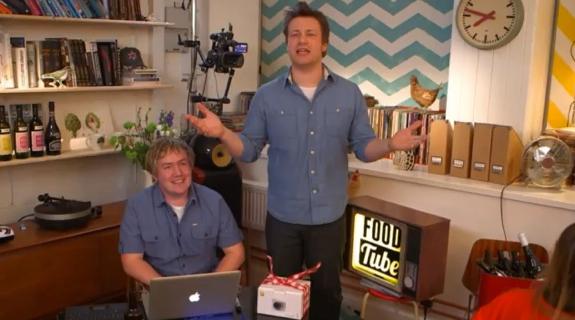Jamie Oliver, the celebrity chef and creator of Food Tube, remarked several times that he is not a digital native during Monday’s Advertising Week panel about creating profitable content for the Web while maintaining authenticity. That may be the case, but it hasn’t kept his YouTube channel from acquiring more than one million subscribers and partnering with some of the biggest global brands since it’s launch in 2013.
It also didn’t keep him from providing insight as to what works when it comes to creating programming for Web viewers alongside actual digital natives Laura Vitale, of the online cooking show Laura in the Kitchen and Michael Stevens, whose YouTube channel of educational videos is called VSauce. Together, the panelists, moderated by Mark Boyd of the content creation business Gravity Road, broke down what, in their experiences, has made their highly trafficked Web channels so successful.
“One thing I have learned is that it’s not how well you know your audience, it’s how well they feel they know you,” said Stevens in response to Oliver’s assertion that commissioners of traditional TV shows don’t really understand their viewers. “What helped me build my audience early on was the idea of ‘here I am in my hotel room, making this for you and I’m letting you in to my world,’” he continued, highlighting one of the elements each panelist agreed was a factor required for success: engagement.
Vitale, who says she tries to respond to each and every viewer tweet, said a key for her has been making sure her audience feels heard.
“I’ve paid very close attention from the beginning to what they like and don’t like,” she said. Viewers have relayed comments about things as minor as pulling her hair back while she’s cooking. “I fix those things. It’s about how well they feel they are being heard.”
Experimentation is also a key consideration. Oliver said the reason he transitioned to the Web was that traditional television is risk averse and doesn’t have a template for testing. He has introduced new talent through his Web series, something for which the “stodgy” TV commissioning process doesn’t allow. But collaborations with lesser-knowns have been successful on Food Tube.
“We have put people on who haven’t been seen before, but when people come to the channel they are more than happy to watch someone who I feel is wonderful. It is a community,” he said.
Stevens also has done well collaborating with other channels, claiming it is the fastest way to grow an audience.
“We are friends with our viewers and they want us all to be friends with each other,” Stevens said. In fact, Oliver’s Food Tube hosted a live VSauce show nearly one year ago. Stevens wasn’t paid for the guest appearance, but said the experience of doing a live show was worth it.
“You scratch my back, I scratch yours,” said Oliver. “Then there may be some money in the future.”
Which brought the discussion around to the panel’s final topic: revenue, brand partnership and authenticity.
Google ads bring in the majority of Vitale’s income, but brand integration is a moneymaker for all three panelist’s channels.
Stevens stays true to VSauce’s educational theme by exploring the science behind the products that approach him. Food Tube has an entire sub-channel sponsored by Bacardi. Boyd teased Vitale about endorsing Nutella, whom she revealed is actually not a sponsor.
“With good brand integration you can’t tell what is and what’s not. Nutella? They aren’t, but they should be!” Vitale laughed.
Tags:













































__twocolumncontent.jpg)











